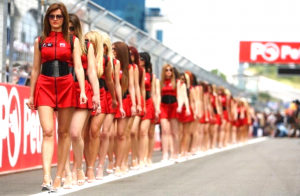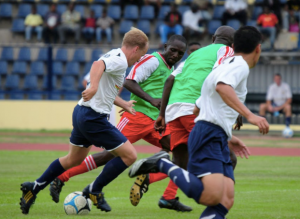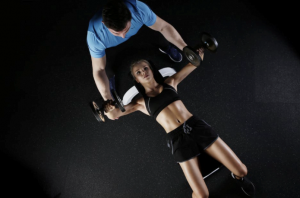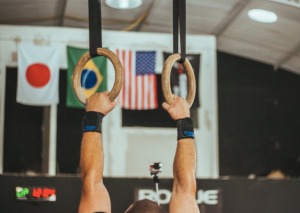by Olivia Heathfield
“All the freshers have to down pints… eat cat food, and lots of other random things” (Dempster, 2009:490).
Hegemonic masculinity is a concept that was developed by Connell (1987). This type of masculinity is considered to be the most dominant and idealised form of masculinity. It is commonly displayed by young, white, male adults who behave in way s that are considered ‘normative’. Connell (1995) explained that hegemonic masculinity was displayed in sporting activities at universities and I consider that rugby boys at Exeter University are definitely seen as the ideal by many other students at this university.
s that are considered ‘normative’. Connell (1995) explained that hegemonic masculinity was displayed in sporting activities at universities and I consider that rugby boys at Exeter University are definitely seen as the ideal by many other students at this university.
Rugby Varsity
Exeter University is one of the top universities for rugby. Each year, two big varsity matches are held where students can watch and support Exeter’s 1st rugby team. The rest of the Rugby Society congregate together in the stands… and there are a lot of them. To say they are hard to miss is an understatement. Firstly, they are all dressed in the same brown chinos, blue shirt and green tie, highlighting their collective sporting success (Dempster, 2009). Secondly, you can hear them drunkenly chanting from a mile away. They start drinking hours before the match and their rehearsed chants contain lyrics which are insulting and derogatory. For example, when Exeter played against Cardiff Met, the Exeter rugby boys chanted “Your mum cleans Lafrowda”. This chant implies that students at Cardiff Met are from less privileged backgrounds because they attend a non-Russell group university. Thus, Exeter rugby boys are attempting to show off academically as well as through sport. Obnoxiously insulting the other university clearly displays elements of hegemonic masculinity – they are ultimately trying to prove that they are the best. Moreover, at several varsity matches I witnessed physical fights between the rugby boys from Exeter and the rugby boys from the opposing university. Again, this is a way that rugby boys assert their dominance over others in order to prove that they are at the top of the masculinity hierarchy.
TP Wednesdays

Many of the rugby boys fit the idealised masculine body image – big, tall, muscly, strong (Light and Kirk, 2010). Therefore, it is not surprising that the rugby boys draw a lot of attention to themselves during a Wednesday TP (Timepiece) night out. Just like at varsity, they wear the same brown chinos, blue shirt and green tie and so, along with their tall and muscular physique, they are very easy to spot in the club. They are able to “brand themselves”, making them stand out from the “common herd” (Dempster, 2009:491). Moreover, they have a reputation for engaging in multiple sexual relations. According to Dempster (2009), rugby boys at universities view women as sexual objects, and I agree that the rugby culture at Exeter university encourages this. This is an element of hegemonic masculinity as this group holds dominance over women (Connell and Messerschmidt, 2005). So, on a Wednesday night in TP, it almost seems like a competition as to who can ‘pull’ the most girls. They do this to show off their sexual prowess and ultimately, prove that they are the most idealised, masculine man. This is reinforced further by the fact that many girls view this type of man as the most attractive (Light and Kirk, 2000). If girls want you, then you are doing something right… I guess.
Rugby Socials
 Heavy drinking at university is considered to be a behaviour that displays elements of hegemonic masculinity (Dempster, 2009). Exeter rugby boys commonly engage in heavy drinking, especially during their Wednesday sports socials. They show off their masculinity by proving that they can drink multiple pints or by drinking a pint as quickly as they can. At socials, they are constantly forced to drink. I was very surprised when my friend who is in the Exeter Rugby Society told me that he drank 22 pints within the space of 2 hours! Also, freshers (first years), as part of their initiation, are forced to engage in acts that highlight their ability to withstand pain and embarrassment. These acts include getting naked and drinking or eating things like cat food (Dempster, 2009). Quite frankly, you do not even want to know what one boy drank this year in order to earn the role of the mascot at varsity.
Heavy drinking at university is considered to be a behaviour that displays elements of hegemonic masculinity (Dempster, 2009). Exeter rugby boys commonly engage in heavy drinking, especially during their Wednesday sports socials. They show off their masculinity by proving that they can drink multiple pints or by drinking a pint as quickly as they can. At socials, they are constantly forced to drink. I was very surprised when my friend who is in the Exeter Rugby Society told me that he drank 22 pints within the space of 2 hours! Also, freshers (first years), as part of their initiation, are forced to engage in acts that highlight their ability to withstand pain and embarrassment. These acts include getting naked and drinking or eating things like cat food (Dempster, 2009). Quite frankly, you do not even want to know what one boy drank this year in order to earn the role of the mascot at varsity.
Not all rugby boys?
It is easy to stereotype all boys who play rugby at Exeter university as rowdy, obnoxious, intimidating and disrespectful to girls. Individually, most of these boys appear to be nice and normal. Yet, when they come together, they perhaps feel that they have to prove their masculinity in the face of other boys who are also trying to be the most idealised form of masculinity. Gender acts as a key feature of one’s identity, and Warin and Dempster (2007:891) argue that through gender, “laddishness” is adopted “as a form of social currency in the early stages of their new lives at university”. Therefore, it can be argued that hegemonic masculinity is adopted by rugby boys at Exeter University because their rugby culture reinforces this type of masculinity.
Connell, R. 1995. Masculinities. Cambridge: Polity.
Connell, R. 1987. Gender and power. Sydney, Australia: Allen and Unwin.
Connell, R.W. and Messerschmidt, J.W., 2005. Hegemonic masculinity: Rethinking the concept. Gender & society, 19(6), pp.829-859.
Dempster, S., 2009. Having the balls, having it all? Sport and constructions of undergraduate laddishness. Gender and education, 21(5), pp.481-500.
Light, R. and Kirk, D., 2000. High school rugby, the body and the reproduction of hegemonic masculinity. Sport, education and society, 5(2), pp.163-176.
Warin, J. and Dempster, S., 2007. The salience of gender during the transition to higher education: male students’ accounts of performed and authentic identities. British Educational Research Journal, 33(6), pp.887-903.








